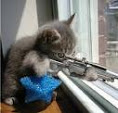One of the target drills practiced with the 5" naval rifles found on most of the tin-can Navy was an anti-surface target shoot. Basically, an ocean-going tug would tow a target sled; the warship participating would lock its fire-control radar onto the target sled and shoot it with BL&P[1] rounds.[2]. A spotter on the tug would watch for the splashes and impacts of the rounds on the sled and grade the ship on its accuracy of fire.
The target sled was tracked by radar in Gun Plot, where a fire controlman (FC) would designate the radar blip of the target to the gunfire control computer. The gunfire control computer took in the ship's course and speed, the target's course and speed, as well as the wind and other factors to generate a firing solution. It was normally an easy exercise, it was a full-up test of the gunfire system. A failure usually meant that something was broken or out of calibration. A failed exercise was usually followed by a CASREP.
The Spruance class introduced a more-computerized fire-control system, the Mk-86, that was designed to have a faster reaction time against small, fast-moving patrol boats. So in the late `70s, one of the then-new Spruance-class destroyers was taking part in an anti-surface gunfire exercise. The target sled was deployed and the range was clear.
The ship opened fire on the target. The Mk-86 tracked the target, tracked up the tow line, and fired on the tug. Accounts differ on the number of times that the tug was hit before the ship was able to cease fire, but it was apparently more than once. The word was that one 5" round went into the Goat Locker.[3] Nobody was injured by the shelling.
The immediate fix was to double the length of the towline anytime that a Mk-86 equipped ship was to shoot at a towed target. The other fix was to require that the ships also optically track targets in gunfire exercises.[4] Depending on who you talked to, the story I heard was that the coaxial TV camera for the gunfire radar was either out of commission or not installed at the time of the incident.[5]
Lore has it that the tug was unofficially awarded a Purple Heart by the destroyer's captain.
___________________________________
[1]BL&P stood for "blind, loaded and plugged". BL&P projectiles had no fuzing and they were loaded with an inert material to make them weigh as much as war rounds. The projectiles were painted blue and they weighed over fifty pounds.
[2] 5" guns used "semi-fixed" ammunition. "Semi-fixed" meant that what appeared to be the cartridge case was the powder casing, the projectile was loaded separately. The powder case also weighed over fifty pounds. The other types of ammunition were "fixed" (like small arms ammunition) and "bag" (the powder was in silk bags), used in battleships and pre-war cruisers.
[3] A/k/a the Chief Petty Officers' Quarters.
[4] This was SOP in the earlier Mk68 GFCS, as the gunfire director itself was manned.
[5] I'll go with "not installed."
The Ferry
4 hours ago

2 comments:
CO of The Sullivan was relieved a few months ago for shooting at a fishing boat instead of the towed target. Now that's an "oops."
Yup, sounds familiar. When I was in the Navy I was at a unit where we calibrated the "computer"[1]s on the Strikecraft. This shit really happened, but before I was there. They tow a sock behind a plane[2], lock the tracking radar to the sock, and then crank up the two Oto Melaras (small stuff, 62mm ISTR). Live ammo, proximity fused.
And yea, the radar tracked up the cable, and as there is a fellow with (hopefully) keen eyes manning the Big Red Switch on the bridge when these things go down the situation was resolved without loss of life or even honour, and the story goes that there was a ceremonial bottle of brandy and set of clean jocks presented to the pilot.
[1] Synchromotors and gears. Beautiful stuff, but it was past state of the art when we got it from the Israelis in the 70s.
[2] Provided by the Air Force
Post a Comment